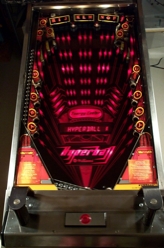In the 1980′s pinball manufacturers searched desperately for ways to stay relevant to a public that increasingly chose videogames over their mechanical cousins. After bankruptcies and consolidation, the industry settled on licensing movie and TV show trademarks as their path forward. But in the early ’80s, they were still trying to be creative.
I’m back at my cliff
still throwing things off
In 1982, Williams introduced perhaps one of the most ill-advised pinball machines ever made: Hyperball. The game was basically Tempest without a monitor. Instead of moving a little vector shape around a playfield, you rotated a cannon left and right at the bottom of a pinball chassis. Instead of firing bolts of energy, you shot ball bearings at a rate of up to 250 balls per minute. (Pinball geeks get all snitty when you describe Hyperball as a pinball machine. They’re wrong. It may use nonstandard rules, different sized balls, and have no bumpers, but it’s a pinball machine by the “how would your mother describe this device?” rule.)
I listen to the sounds they make
on their way down
The game was incredibly loud, even by arcade standards. Each ball was launched with a loud THUNK-fwip, targets clattered as you hit their flaps, balls smacked onto wooden pieces of the playfield. And of course, ball bearings that missed targets collided with newly fired shots, and ricocheted loudly off of the glass plate covering the playfield. Multiply that by the rapid rate of fire, and the noise was truly deafening. Perhaps overcompensating for this mechanical cacophony, the electronic sound effects of the game were equally loud, a pastiche of samples borrowed from Defender and Robotron (such as this one).
I follow with my eyes ’til they crash
I imagine what my body would sound like
slamming against those rocks
The mechanics of the game were simple and twitchy. The playfield had a number of “target” flaps with letters in front of them. Red lightning-bolt shaped lights stretched from the targets down to your cannon. As the game went on, the lights illuminated, one by one, marching downward in columns. If you shot a ball into the flap or hole associated with a column, the bottom most light went out; the effect was as if you were “beating back” the lights. If a lightning bolt reached the bottom of the playfield, you lost a life.
I’m simplifying the game a bit — you also had smart bombs, for example, which destroyed everything on the playfield — but that’s the basic idea.
and when it lands
will my eyes
be closed or open?
The gun was not fully automatic, and had two triggers, once for each hand. You had to pull a trigger for each ball fired. The gun could be fired at a faster rate than you could pull the triggers, so this led to all sorts of odd “chording” finger patterns on the triggers which could induce terminal carpal tunnel syndrome in about 10 minutes.
Hyperball was designed by Steve Ritchie, who designed a number of games, including the classic (or infamous, depending on your taste) Black Knight. Hyperball occupied a strange niche, and it showed. It wasn’t videogame enough to draw in videogame players with regularity, and it wasn’t pinball enough to draw in pinball players either. I tried it a couple of times to slake my curiosity, and then left it alone, saving my quarters for other, more traditional machines. Because of the tremendous beating each game exerts on the chassis and mechanical components, there aren’t too many of them left in good working condition.
Only 4,444 of these machines were ever produced.
Additional Resources
- The photo of the Hyperball playfield used in this article came from Mark Gibson, via the Internet Pinball Machine Database
- There’s another nice writeup of Hyperball maintained by a fan.
- Excerpts from “Hyperballad” by Björk used without permission.






By god my new goal is to find and play this game at least once.
I hope I’m not as disappointed as I was when I found a working Hercules pinball game at Cedar Point…
Ugh, yeah, Hercules was the epitome of the “sounds better than it is” pinball. I found one on the Jersey Shore — Point Pleasant, I think? — and it was slow, lumbering, and completely boring. (For those of you unfamiliar with it, “Hercules” was a double-wide and generally outsized pinball machine by Atari that used a pool cue ball (if I recall correctly?) rather than standard pinballs.
I do remember liking some of Atari’s other pinball efforts, though, notably “Superman.”